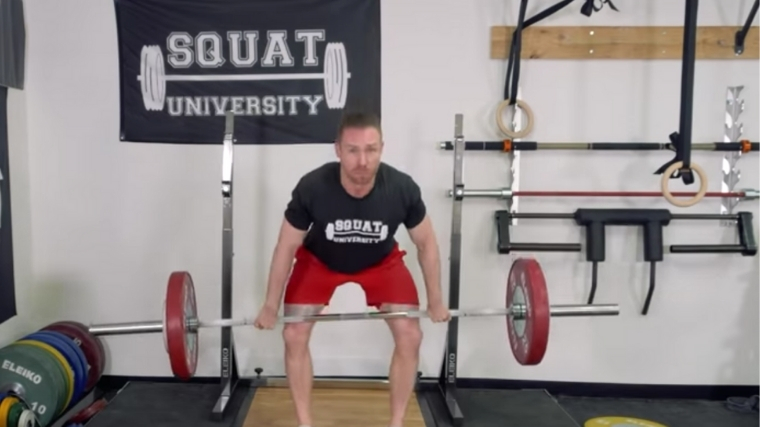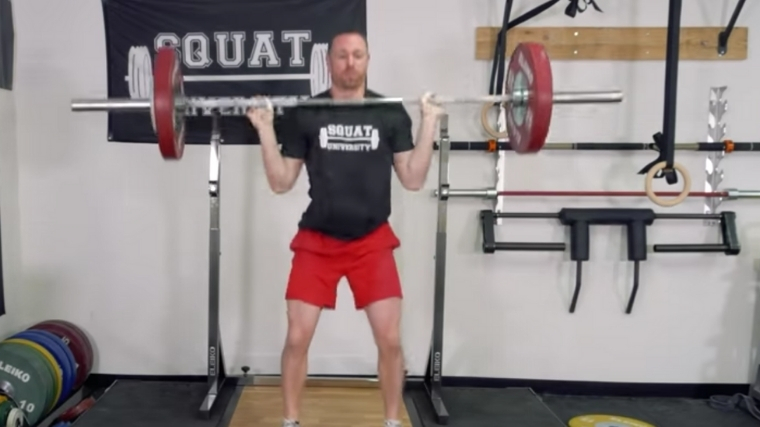One issue with Olympic lifts is that they take a lot of time and skill to master. So, most gym-goers probably aren’t programming the clean & jerk and snatch into their workout program. That said, there’s a lot of power and strength to be gained from these complex exercises. That’s why we suggest trying the power clean — a clean & jerk variation that focuses on the first phase of the movement. It’s easier to learn and execute and yet offers the same power benefits as other Olympic lifts. As a result, you’ll be more explosive during just about any other hip-hinge based movement (think deadlifts, hip thrusts, and kettlebell swings)
Not sure where to start? No worries. In this guide, we’ll show you how to do the power clean, break down its benefits, and provide some alternatives and variations.
- How to Do the Power Clean
- Benefits of the Power Clean
- Muscles Worked By the Power Clean
- Who Should Do the Power Clean
- Power Clean Sets, Reps, and Weight Recommendations
- Power Clean Variations
- Power Clean Alternatives
- Frequently Asked Questions
How to Do the Power Clean
In the below step-by-step guide, we’ll go over every phase of the power clean and how to perfect it.
Step 1 — Load the Quads and Hips

Stand in front of a barbell with your feet shoulder-width apart, and grab the barbell with an overhead grip. With the knees slightly bent, push your feet through the floor to build tension in your quads. Your back should be slightly arched, too. Now, deadlift the bar off of the ground.
Form Tip: Keep your knees pressed outward slightly to create more tension in your glutes and hamstrings, which will help with the initial lift-off.
Step 2 — Pull and Catch the Bar

Once the bar is at hip height, thrust your hips forward and keep pulling the bar up your body. Once it’s nearing shoulder height, drive your elbows down and under the bar, so the barbell is resting across your shoulders in a front rack position. Receive the barbell in the partial front squat position.
Form Tip: Initiate the pull by pushing through the floor using the legs rather than lifting with the arms or back.
Step 3 — Get Set, Then Start Your Next Rep

Once your body is stable, stand up and repeat. Then, drop the bar back down for a repeat rep.
Form Tip: It’s ok if your feet stagger a bit to gain balance. This will happen, especially as you lift heavier and heavier weights.
Benefits of the Power Clean
Whether you’re a CrossFit athlete, looking to improve your Olympic weightlifting, or are a general gym-goer who wants to be a bit more powerful — here are three benefits from doing the power clean.
More Power
Power cleans will help you increase muscular coordination, power output, and overall athletic capacity. Explosive compound movements in nature often produce amazing results in power and force output, kinesthetic awareness, and neurological adaptations needed to train harder, run faster, and be a more explosive athlete. This is why a lot of college strength and conditioning programs use the power clean.
Better Olympic Lifts
The power clean is essentially the first third of the clean & jerk. If you’re a competitive weightlifter, then your initial pull from the floor during the standard clean & jerk will get stronger.
Improved Clean Technique
The power clean can help lifters who fail to reach full extension in the clean and/or do not finish the pull with aggression. By not allowing the lifter to move into the full front squat, you force them to produce more power and secure the load in the higher squat position. You can also use this as part of a complex for lifters who may have issues bridging the gap between full cleans and power cleans.
Muscles Worked By the Power Clean
The power clean is a complex movement that primarily works the posterior chain; however, it is still highly stressful to the legs, back, and core stabilizers. The below muscle groups are all active during the power clean.

Hamstrings and Glutes
The hamstrings and glutes are most active during the first phase of the movement when you lower the barbell to your knees. By doing this, you’re accumulating tension in your hamstrings and glutes — like a spring — and then releasing that tension to drive the barbell up.
Quadriceps
The quads aren’t that engaged during this lift, but they are under load when you complete the partial squat phase of this lift at the apex of the exercise.
Back and Traps
Your back and traps are really engaged when you pull the barbell up to the front rack position. They’re also active as you stabilize the bar in the front rack position, as those muscles prevent you from falling forward with the weight.
Who Should Do the Power Clean?
The power clean is a power-based movement that can aid in overall athletic development and explosive strength in all lifters. Below are a few lifting populations who can benefit from such a movement.
Strength and Power Athletes
Strength and power athletes can use the power clean to improve overall athleticism, power production, and explosive strength. Additionally, Olympic weightlifters can use power cleans to maximize their clean and jerk performance.
- Powerlifters and Strongmen/Strongwomen: Increasing power production at the hip and legs will allow you to move weight faster and breakthrough sticking points at the hip (which will help your deadlift lockout). This move isn’t a must-add to a powerlifter/strongman’s program, but it can help boost full-body strength and power for other hip-based movement patterns.
- Olympic Weightlifters: The power clean can help a lifter become more aggressive and powerful during the final stages of the pull. It can also be used as a clean & jerk variation to train the clean without adding excessive lower body volume (such as during squat-focused programs). Lastly, this can be used to help a lifter establish better timing and an understanding of how to meet the barbell to where it is pulled, rather than simply diving under barbells and having the weight crackdown on their collarbone.
Functional Fitness Athletes
Power cleans are widely used in WODs, and so they’re a key exercise to master. Aside from the specific aspect of including power cleans into training, the power clean can improve Olympic weightlifting technique and performance much like a weightlifter would integrate them in their training. Lastly, like most explosive movements, increased force and power output can lead to faster sprint times, longer/higher jumps, and more force when hitting balls, throwing objects, and tackling opponents.
Power Clean Sets, Reps, and Weight Recommendations
Below are three primary training goals and programming recommendations for them when performing the power clean.
To Improve Technique
For training technique and skill, it is best to use light to moderate load. Do three to five sets of three to five reps with 50 to 70 percent of your one-rep max. Be sure to emphasize proper positioning, timing, and speed.
To Increase Power Output
Perform four to six sets of two to three repetitions, using 65 to 80 percent of your 1RM. When in doubt, lower the weight on the bar and really explode during the movement.
To Bolster Strength
Do five to 10 sets of one to two reps with 80 percent or more of your 1RM. Heavy power cleans can be done to increase overall clean performance, pulling power and strength, and/or to help increase the clean and jerk under heavier, near-maximal loads (which itself is a skill).
Power Clean Variations
Below are two common power clean variations that can be done to improve performance/skill, increase strength, and more.
No-Foot Power Clean
The no-foot power clean is done identically to the power clean, except that the lifter does not lift or slide the feet after extension and while moving into the partial squat. The stance itself should be slightly wider at the start (squat stance) when compared to a regular power clean. This variation forces vertical extension and balance in the pull. Additionally, it forces the lifter to transition under the barbell smoothly and secure a front rack position without having the barbell crashing down on them as they move over the bar. This is great for lifters who tend to throw their hips forward or let the weight crash on them.
Block Power Clean
The block power clean is simply a power clean with the weight elevated on rocks. This higher starting point shortens the pull and forces the lifter to exert even higher power output to move the load and secure it in the partial squat position. This is also a great variation to work with beginners because it makes the pulling phase shorter and omits the more complicated first pull and transition phase around the knees. Also, most lifters can handle heavier weight in this position due to the reduced range of motion.
Power Clean Alternatives
Below are two power clean alternatives that can be done to vary programming, challenge lifters, and more.
Dumbbell Hang Power Clean
The dumbbell hang power clean is a great way to help beginners and/or lifters who may not have the ability to perform the clean with a barbell. The dumbbell hang clean can also be a good way to take the stress off the wrist — as the barbell loads it in an extended position — while still training the general movement pattern of the clean.
Kettlebell Clean
Like the dumbbell clean, the kettlebell clean is a variation of the barbell power clean that can be a good alternative if someone does not have access to a barbell. The kettlebell clean also forces unilateral strength and stability both in the pull and front rack position, which could increase upper body strength if that is an issue. While the movement patterning is not identical to the barbell power clean, it still trains similar movement patterning and muscle groups.
FAQs
Can beginners do power cleans?
Yes. Power cleans are a good beginner movement as it doesn’t require the beginner to perform a full squat. That said, sometimes the hang power clean or block power clean is a better option for beginners as they do not have to perform the full pull from the floor, simplifying the lift. Nonetheless, you can have them also perform power cleans + front squats to help them transition to full squats.
What is the difference between a full clean and a power clean?
The power clean has the lifter secure the weight in the front rack while in a partial squat, whereas the full clean allows the lift to transition into the full-depth squat.
How many sets and reps of the power clean should I do?
Here’s a quick roadmap for choosing your set and rep schemes.
- To improve your technique: Do three to five sets of three to five reps with 50 to 70 percent of your one-rep max.
- For more power: Perform four to six sets of two to three repetitions, using 65 to 80 percent of your 1RM.
- For more strength: Do five to 10 sets of one to two reps with 80 percent or more of your 1RM.
Featured image: Sirichai Saengcharnchai/Shutterstock